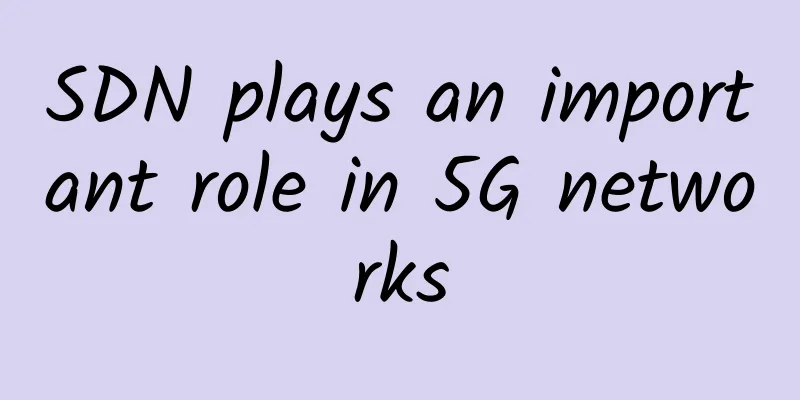SDN plays an important role in 5G networks

|
In many ways, 4G networks are already falling behind. New data interaction patterns and an increasing number of connected devices are two major forces forcing operators to seek the next evolution of wireless data communications. ***5G networks are expected to appear in 2020.
Three years may not seem like a long time to the average consumer, but for those designing and deploying 5G networks, 2020 has come and gone. As the technology evolves, and with so much potential in this next generation of wireless, operators are looking for new ways to improve performance, automate processes and create a ubiquitous network that connects users wherever they are. Wireless carriers have three main goals for 5G networks: increased productivity, higher speeds and lower latency. To achieve these goals, the largely incorrect assumption is that simply refreshing the hardware and software with cutting-edge technology will do the trick. In order to build and maintain a network that can handle a thousand times more devices, provide 100 times faster connections and latency below 1 millisecond, the entire network must operate at high speed all day long. This type of network cannot be simply built with the current architecture consisting of independently operated parts. Instead, the industry needs a completely new approach that can provide end-to-end visibility and the ability to operate the network, treating all the independent parts as a unit. Since SDN can build and change networks centrally, rather than network managers manually migrating between devices, this is where SDN comes in handy in 5G networks. SDN can bring four major benefits to 5G networks 5G wireless will extend the boundaries of a given available spectrum, therefore, SDN in 5G networks can make 5G work seamlessly across the entire plane. A network with an underlying SDN architecture can achieve this by providing the following four advantages: 1. With the increase of data in 5G network, more efficient data flow is provided Data no longer needs to be routed through the core of the network, instead, SDN will be applied to the transmission of traffic between the source address and the destination address. This can effectively increase speed and reduce latency while eliminating potential bottlenecks common in current generation architectures. 2. The content cached in the operator network is usually closer to the needs of end users Such large-scale data caching requires end-to-end network visibility on the back end, and the SDN architecture is well suited to reduce network bandwidth requirements and lower latency. 3. Use SDN to build centralized control management and automation in 5G networks to eliminate network redundancy Compared with traditional dynamic routing protocols, SDN routing decisions are more intelligent. A well-configured SDN network can overcome the impact of catastrophic outages by intelligently recalculating data flow routes. 4. SDN can ensure scalability and dynamic configuration Operators no longer need to manually scale networks when expanding into new areas, or add capacity to existing areas. Obviously, installing equipment in new areas still requires manual work, but from a configuration perspective, SDN supports automatic setup after construction. Like 3G and 4G networks, 5G will be used for the next 10 years or more, which means operators can put in as little extra effort as possible. Drivers of 5G Networks While 5G networks will be rolled out over the next few years, the continued growth of mobile devices and the Internet of Things is expected to increase the sense of urgency in the wireless operator vertical. Today's 3G and 4G networks will be unburdened by the arrival of 5G networks, and it is critical that operators follow their established 5G goals. The best way to achieve their network end-to-end goals is to use an SDN architecture. |
Recommend
Without big data and artificial intelligence, you may not be able to eat if you are hungry
【51CTO.com original article】 Friends born in the ...
Weekend news! Under the US ban, Huawei has won over another major European country and become a core 5G supplier!
Because of 5G technology, the United States has s...
What to do when you encounter a network failure? Teach you a trick to use route tracking to locate the fault point
In the Internet world, we interact with various n...
5G is still being promoted, and 6G is coming?
There is increasing attention on 6G. [[424661]] A...
The impact of edge computing and 5G on future channel business
Last year, the COVID-19 pandemic has made us even...
Leading the new trend of the trillion-dollar cloud video market, Huichang Communication was successfully listed on the Growth Enterprise Market
On January 25, 2017, Shanghai Huichang Communicat...
Anynode: $15/year KVM-1GB/20G SSD/2TB/Las Vegas
The last time I shared information about Anynode ...
my country's 5G enters a substantial acceleration phase and is ready for commercial use
It is already March 2018, and the large-scale com...
DesiVPS: Los Angeles 1Gbps unlimited traffic VPS from $18.99 per year, Netherlands VPS from $20 per year
DesiVPS's latest promotion is similar to the ...
After running blindly, how much money did operators make from 5G?
[[347740]] Recently, China Mobile and China Unico...
Super detailed explanation of Socket communication principles and examples
We are well aware of the value of information exc...
80VPS: AMD Ryzen+NVMe Los Angeles Cera Data Center KVM annual payment starts at 349 yuan
80VPS is a well-established Chinese hosting compa...
spinservers: 10Gbps bandwidth high-end server starting at $89 per month, Dallas/San Jose data center
spinservers is a business that mainly provides ov...
The secrets of the mobile data war: "Unlimited" is conditional
As the deadline for the cancellation of roaming c...
How to set up a new router?
[[426343]] 1. Router startup initial sequence Whe...









